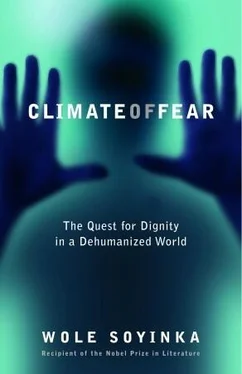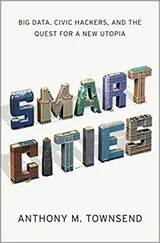We are all agreed, I like to believe, on what constitutes fear. If not, we can at least agree on the symptoms of fear, recognize when the conditioning of fear has afflicted or been imposed on an individual or a community. Certainly we have learned to associate the emotion of fear with the ascertainable measure of a loss in accustomed volition. The sense of freedom that is enjoyed or, more accurately, taken for granted in normal life becomes acutely contracted. Caution and calculation replace a norm of spontaneity or routine. Often, normal speech is reduced to a whisper, even within the intimacy of the home. Choices become limited. One is more guarded, less impulsive. A rapist is on the loose in society. A serial killer terrorizes an entire community — as happened recently in the state of Maryland in the United States, where two men, an adult and his protégé, placed an entire state under siege as they picked off victims at random.
Now, such a disruption induces a totally different sensation from that created by a war situation, where a town is placed under siege. Even if bombs and rockets are raining down on the populace without cessation, the very process of war permits a certain space of volition, and thus reduces the inner debilitation that comes with a sense of impotence. In the case of Maryland, the murdering pair succeeded in making fear the controlling factor for a population. This anonymous force shut down schools and institutions and destabilized normal existence. Parents took to escorting their children right into the schoolroom, with a look cast over the shoulder. Obviously, while the killing spree lasted, there was deep resentment of, even rage at, the unknown assailant, but the commonest product of that phase was simply undirected fear. A notable aspect of all-pervasive fear is that it induces a degree of loss of self-apprehension: a part of one’s self has been appropriated, a level of consciousness, and this may even lead to a reduction in one’s self-esteem — in short, a loss of inner dignity. Not always, admittedly, and those times when such a claim is invalid offer us the chance of making some crucial distinctions among the various contexts within which fear takes its especial quality.
It so happens that I recently underwent an experience that enables me to reinforce such a distinction, one that may explain why the experience of fear is actually more tolerable in some circumstances than in others — in other words, there does exist a kind of fear one can live with, shrug off, one that may actually be absorbed as a therapeutic incidence, while others are simply downright degrading. I refer to the recent fires that ravaged southern California and resulted in the devastation of one of the largest swaths of land, we are told, in the history of fires in the United States. I was one of those thousands of residents who found their homes in the path of the ravenous invader, unable to predict — literally— which way the wind would blow.
Well, let me describe what I observed in the comportment of neighbors. They were anxious, of course, and fearful. Watchful and insecure. But their humanity was not abused or degraded by the menace that bore down on them. On the contrary, they remained in combative form, constantly exchanging news as well as tactical suggestions for saving the neighborhood. Sleep was out of the question. At any moment, we had been warned, police sirens and fire-truck Klaxons could rip through the night, signaling the moment for compulsory evacuation. As the fires came closer, choices became reduced. Sprinklers lost power, garden hoses gave up the last trickle, and we began to wonder if electric power was now threatened. Indeed, a blackout soon followed. Our endangered community became apprehensive of the worst — but no one was truly intimidated, nor was there the slightest sign of a loss of dignity.
The relationship between that fire, a naked force of Nature — even though probably the work of arsonists— and the humanity that was menaced was very different from the exercise of the power of an individual over another, or that of a totalitarian state over its populace. There exists a vast abyss of sensibilities between the raw force that is Nature, on the one hand, and the exertion of force by one human being in relation to another. I suggest that this has to do with yet another human possession, an attribute that is as much a social acquisition as it is inherent in the human species — dignity. A number of philosophers — Hegel, Locke, and so on — even stretch this notion of self-esteem to the human need for recognition. This last is a concept of which I am not particularly enamored, and I find the bulk of expository literature on that extended impulse mostly unsatisfying — we shall touch again on this theme in our fourth lecture, “The Quest for Dignity.” For now, let us simply observe that the assault on human dignity is one of the prime goals of the visitation of fear, a prelude to the domination of the mind and the triumph of power.
A few decades ago, the existence of collective fear had an immediately identifiable face — the atomic bomb. While that source is not totally absent today, one can claim that we have moved beyond the fear of the bomb. A nuclear menace is also implicated in the current climate of fear, but the atom bomb is only another weapon in its arsenal, the theoretical do-it-yourself kit that fits into a suitcase and can be assembled in the nearest bathroom.What terrifies the world, however, is no longer the possibility of over-muscled states unleashing on the world the ultimate scenario — the Mutual Assured Destruction (MAD) that once, paradoxically, also served as its own mutually restraining mechanism. Today the fear is one of furtive, invisible power, the power of the quasi-state, that entity that lays no claim to any physical boundaries, flies no national flag, is unlisted in any international associations, and is every bit as mad as the MAD gospel of annihilation that was so calmly annunciated by the superpowers.
The last century, post — Second World War, was indeed dominated by the fear of a nuclear holocaust. That fear, let it be noted, however, was only a successor to another. It replaced, once the war was over, yet another collective fear — that of world domination by a fanatic individual who preached, and sought to actualize, a gospel of race purity. In the cause of that mission, some millions of humanity were systematically annihilated, while millions more perished on fields of battle that stretched from the North Pole to the South Sea Islands. As I narrated in my childhood memoirs, Aké: The Years of Childhood, the figure of Adolf Hitler was one fearsome presence that percolated distances all the way from embattled Europe to farflung colonial possessions. Parents invoked Hitler as the bogeyman to quiet the obstreperous child. Households were compelled by decree of the colonial officer to darken their windows at night. Infractions were penalized by fines. And when, finally, a cargo ship caught fire on the lagoon in the capital city of Lagos, and explosions shattered windows even far away from the marina, we, as children, had no doubt that the Terror of the Free World had indeed arrived to cart us off into slavery.
That universal season of fear ended on the battlefield. In its place rose the fear of the very weapon of the world’s liberation — at least, that was the excuse— whose devastating effects appeared to have no limitations. The literature of science fiction took a swing toward prospects of a devastated world, peopled by mutants in whom the loss of the last vestiges of humanity would be reflected in their very physical decomposition. The cinema bore graphic witness to this mood. Beyond the grotesquerie, the caricatures, and the gallows humor of Dr. Strangelove was a more than subterranean revelation of a penetrating fear, a caution, and a strong moral message to the world to pull back from the nuclear brink. Nothing was left to chance in its aim of exacting a moral apprehension of power and destruction through a recourse to negative memory — who can forget Peter Sellers’s manic performance, the arm that jerked up of its own volition in a Nazi salute, an iconography that was surpassed only by the whooping rodeo ride on the back of a nuclear bomb into oblivion and obliteration by yet another obsessed angel of MAD!
Читать дальше












